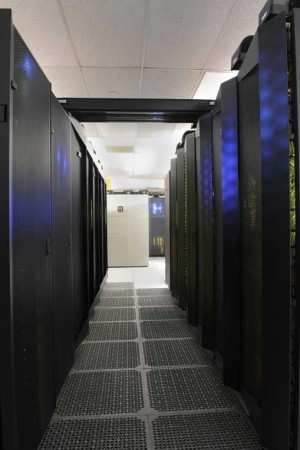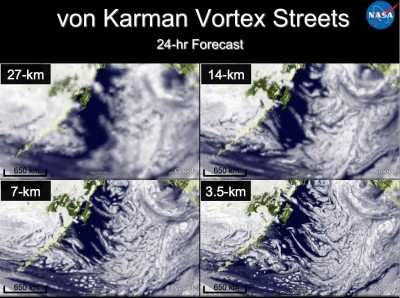Increased Computing Power Could Also Give Greater Accuracy To
Daily Weather Forecasts
 NASA's Goddard Space Flight Center
in Greenbelt, MD this month made available to scientists the first
unit of an expanded high-end computing system that will serve as
the centerpiece of a new climate simulation capability. The larger
computer, part of NASA's High-End Computing Program, will be
hosting the agency's modeling contributions to the
Intergovernmental Panel on Climate Change (IPCC) and other national
and international climate initiatives.
NASA's Goddard Space Flight Center
in Greenbelt, MD this month made available to scientists the first
unit of an expanded high-end computing system that will serve as
the centerpiece of a new climate simulation capability. The larger
computer, part of NASA's High-End Computing Program, will be
hosting the agency's modeling contributions to the
Intergovernmental Panel on Climate Change (IPCC) and other national
and international climate initiatives.
The expansion added 4,128 computer processors to Goddard's
Discover high-end computing system. The IBM iDataPlex "scalable
unit" uses Intel's newest Xeon 5500 series processors, which are
based on the Nehalem architecture introduced in spring 2009.
Discover will be hosting climate simulations for the IPCC's
Fifth Assessment Report by the Goddard Institute for Space Studies
(GISS) in New York City and Goddard's Global Modeling and
Assimilation Office (GMAO). Stimulus funds from the American
Recovery and Reinvestment Act of 2009 will enable installation of
another 4,128 Nehalem processors this fall, bringing Discover to
15,160 processors.
"We are the first high-end computing site in the United States
to install Nehalem processors dedicated to climate research," said
Phil Webster, chief of the Computational and Information Sciences
and Technology Office (CISTO) at Goddard. "This new computing
system represents a dramatic step forward in performance for
climate simulations."
In preliminary testing of Discover's Nehalem processors, NASA
climate simulations performed up to twice as fast per processor
compared to other nationally recognized high-end computing systems.
Moreover, the new computational capabilities allow NASA climate
scientists to run high-resolution simulations that reproduce
atmospheric features not previously seen in their models.

Discover Mainframe
"Nehalem architecture is especially well-suited to climate
studies," said Dan Duffy, CISTO lead architect. "Speed is an
inherent advantage for solving complex problems, but climate models
need large memory and fast access. We configured our Nehalem system
to have 3 gigabytes of memory per processor, among the highest
available today, and memory access is three to four times faster
than Discover's previous-generation processors."
In daily forecasts for NASA satellite missions and field
campaigns, the GMAO typically runs its flagship Goddard Earth
Observing System Model, Version 5 (GEOS-5) at 27-kilometer
resolution. Using Discover's new processors, the GMAO has been
testing a special "cubed-sphere" version of GEOS-5 at resolutions
as high as 3.5 kilometers.
"Once the model goes below 10-kilometer resolution, features
such as well-defined hurricane eyewalls and convective cloud
clusters appear for the first time," said William Putman, acting
lead of the Advanced Software Technology Group in Goddard's
Software Integration and Visualization Office. "At these
cloud-permitting resolutions, the differences are stunning." Putman
has been collaborating with GMAO modeling lead Max Suarez and
others on the cubed-sphere configuration of GEOS-5.

NASA Resulution Comparison
NASA's IPCC simulations will include both
longer-and-shorter-term climate projections using the latest
versions of the GISS and GMAO models. GISS ModelE will perform
simulations going back a full millennium and forward to 2100.
Making its first IPCC contributions, the GMAO will focus on the
next 30 years and perform decadal prediction simulations using
GEOS-5 and atmospheric chemistry-climate simulations using the GEOS
Chemistry Climate Model. With the performance of GEOS-5 on the
Nehalem processors, investigations of societal relevance, such as
climate impacts on weather extremes, now reach a new level of
realism. The IPCC's Fifth Assessment Report is due to be published
in 2014.
NASA climate simulation efforts also contribute to the U.S.
Global Change Research Program, the U.S. Integrated Earth
Observation System, and the U.S. Weather Research Program.
Supported international programs include UNESCO's Intergovernmental
Oceanographic Commission, the United Nations Environment Program,
the World Climate Research Program, the World Meteorological
Organization, and the World Weather Research Program.
 ANN's Daily Aero-Term (04.25.24): Airport Rotating Beacon
ANN's Daily Aero-Term (04.25.24): Airport Rotating Beacon ANN's Daily Aero-Linx (04.25.24)
ANN's Daily Aero-Linx (04.25.24) Klyde Morris (04.22.24)
Klyde Morris (04.22.24) Airborne 04.24.24: INTEGRAL E, Elixir USA, M700 RVSM
Airborne 04.24.24: INTEGRAL E, Elixir USA, M700 RVSM Airborne 04.22.24: Rotor X Worsens, Airport Fees 4 FNB?, USMC Drone Pilot
Airborne 04.22.24: Rotor X Worsens, Airport Fees 4 FNB?, USMC Drone Pilot





